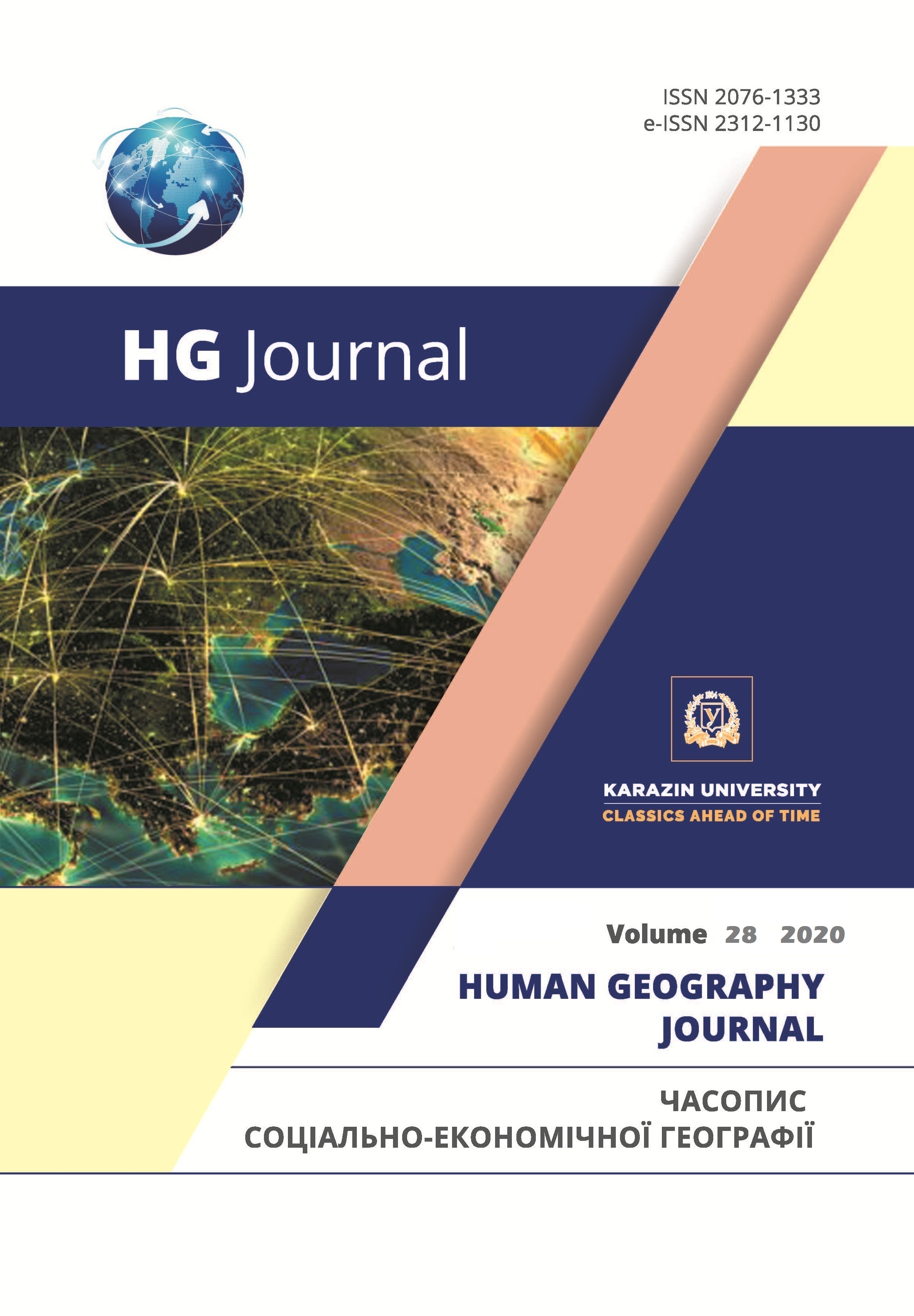Семіотика ландшафту та його візуальний/текстуальний аналіз у англо-американській культурній географії
Анотація
У статті розглянуто розуміння ландшафту з позиції семіотики та критичної соціальної теорії у англо-американській культурній географії та метод візуального/текстуального аналізу ландшафту. Проаналізовано історію зміни підходів до розуміння і дослідження ландшафтів в англо-американській культурній географії з початку ХХ ст. до наших днів, а також розуміння ландшафту у Європейській ландшафтній конвенції. Виявлено, що вживання поняття ландшафт у суспільній географії перш за все має на увазі підкреслення візуального аспекту оточення людини. Було встановлено, що з позиції семіотики ландшафти, крім матеріального (фізичного) виміру, несуть смислове навантаження, передають значення, є системою знаків і можуть читатися як текст.
Представлено аксіоми читання ландшафту американських географів П. Льюїса і Д. Мітчела та положення структуралістської семіотики. Дані теоретико-метологічні підходи застосовуються для дослідження архітектурних стилів адміністративних, житлових садибних та комерційних будинків, пам’ятників та реклами у громадському просторі, топонімів та інших способів символічного маркування простору, а також зображення ландшафтів у медіа (фільмах, новинах, рекламах, картинах, літературі). У статті також розглянуто розуміння ландшафту з позиції критичної соціальної теорії, згідно якої вони беруть участь у конструюванні, підтримці, легітимізації та протистоянні соціальних структур (систем відносин), наприклад національних, політичних, економічних, класових чи гендерних.
Розглянуті у статті підходи дослідження ландшафту є центральними для аналізу візуальних змін середовища життя людей у міській та сільській місцевості, зокрема процесу «декомунізації» в Україні, залучення ландшафту у капіталістичні відносини та практики споживання, у їх комодифікацію та комерціалізацію. Було з’ясовано, що візуальний/текстуальний аналіз ландшафтів також дає змогу виявити цінності та ідентичності людей, виражені у архітектурних стилях нових садибних будинків. Застосування розглянутих підходів є важливим для вдосконалення містопланувальних та архітектурних регулювань з метою створення соціально справедливого середовища з враховуванням історичного, соціального та культурного контексту та потреб різних жителів.
Завантаження
Посилання
Volovyk, V. (2013). Etnokulturni landshafty: regionalni struktury i pryrodokorystuvannya [Ethnocultural landscapes: regional structures and nature management]. Vinnytsia: «Vinnytsia City Printing House» [in Ukrainian].
Grodzynskyi, M. (2005). Piznannya landshaftu: mistse i prostir [Knowledge of the landscape: place and space]. Kyiv: Kyiv University Publishing and Printing Center [in Ukrainian].
Denysyk, H. (1998). Antropogenni landshafty Pravoberezhnoi Ukrainy: monografiya [Anthropogenic landscapes of Right-Bank Ukraine: monograph]. Vinnytsia: Arbat [in Ukrainian].
Denysyk, H. (2014). Antropogenne landshaftoznavstvo: navch. posibnyk, Ch.1: Zahalne antropogenne landshaftoznavstvo [Anthropogenic Landscape Studies: Educ. handbook, Part 1: General Anthropogenic Landscape Studies]. Vinnytsia: Vinnytsia Regional Printing House [in Ukrainian].
Denysyk, H. (2015). Antropogenne landshaftoznavstvo: navch. posibnyk. Ch. 2. Regionalne antropogenne landshaftoznavstvo [Anthropogenic Landscape Studies: Educ. handbook. Part 2. Regional Anthropogenic Landscape Studies]. Vinnytsia: Vinnytsia Regional Printing House [in Ukrainian].
Kovalev, A. (2009). Landshaft sam po sebe y dlya cheloveka [The landscape it self and for the humans]. Kharkov: Burun Book. [in Russian].
Lozynskyi, R. (2020). Povsyakdenni landshafty prymiskykh sil Lvova: vizualnyi analiz postsotsialistychnykh transformatsiy [Everyday Landscapes of Peri-Urban Villages: a Visual Analysis of Postsocialist Transformations]. Visnyk Lvivskoho universytetu. Seria geografichna, 54. In print [in Ukrainian].
Tyutyunnik, Yu. (2019). Landshaft i landshaftnost. [Landscape and Landscapeness]. Kyiv [in Russian].
Evropeyska Landshaftna Konventsiya [European Landscape Convention]. (2000). Retrieved from http://zakon.rada.gov.ua/laws/show/994_154 [in Ukrainian].
Duncan, J., & Duncan, N. (2010). Doing Landscape Interpretation. In D. DeLyser (Ed.). The SAGE Handbook of Qualitative Geography. (pp. 225-247). London, UK: SAGE.
Duncan, N., & Duncan, N. (2004). Landscapes of Privilege. New York: Routledge, https://doi.org/10.4324/9780203505755
Foote, K. E., & Azaryahu, M. (2009). Semiotics. In International Encyclopedia of Human Geography. (pp. 89-94). Amsterdam: Elsevier.
Groth, P. (1997). Frameworks for Cultural Landscape Study. In P. Groth. & T.W. Bressi (Eds.). Understanding Ordinary Landscapes. (pp. 1-21). New Haven: Yale University Press.
Groth, P., & Wilson, C. (2003). The Polyphony of Cultural Landscape Study: An Introduction. In C. Wilson, & P. Groth (Eds.). Everyday America: Cultural Landscape Studies after J.B. Jackson. (pp. 1-22). University of California Press.
Hoelscher, S. (2006). Cultural Landscape. In Encyclopedia of Human Geography. (pp. 75-78). Thousand Oaks, London, New Delhi: SAGE Publications.
Hoelscher, S. (2009). Landscape Iconography. In International Encyclopedia of Human Geography. (pp. 132-139). Amsterdam: Elsevier.
Kuhlke, O. (2006). Critical Human Geography. Encyclopedia of Human Geography. SAGE Publication. P. 66-68.
Lewis, P. (1979). Axioms for Reading the Landscape. In D. Meinig (Ed.). The Interpretation of Ordinary Landscapes: Geographical Essays. (pp. 11-32). New York: Oxford University Press.
Lindström, K., Kull, K., & Palang, H. (2011). Semiotic study of landscapes: An overview from semiology to ecosemiotics. Sign Systems Studies, 39 (2/4), 12-36.
Lozynskyi, R. (2019). Rethinking the Role of Land Privatization in Peri-Urban Transformations in Ukraine: The case Study of Sokilnyky, Lviv oblast. Human Geography Journal, 27, 48-59. https://doi.org/10.26565/2076-1333-2019-27-06
Lukinbeal, C. (2009). Film. In International Encyclopedia of Human Geography. (pp. 125-128). Amsterdam: Elsevier.
Mihăilescu, V. (2016). Reading a House. Migration, Households and Modernity in Post-communist Rural Romania. In R. Betea, & B. Wild (Eds.). Brave New World – Romanian Migrants’ Dream Houses. (pp. 48-57). Bucharest: Romanian Cultural Institute.
Meinig, D. (1979). Symbolic Landscapes. Some idealizations of American communities. In D. Meinig (Ed.). The Interpretation of Ordinary Landscapes: Geographical Essays. (pp. 164-192). New York: Oxford University Press.
Mitchell, D. (2000). Cultural Geography: A Critical Introduction. Oxford, U.K.: Blackwell Publishers.
Mitchell, D. (2008). New Axioms for Reading the Landscape: Paying Attention to Political Economy and Social Justice. In J., Wescoat, Jr., Johnston, & M. Douglas (Eds.), Political Economies of Landscape Change: Places of Integrative Power (pp. 29-50). Dordrecht: Springer.
Morin, K. (2009). Landscape Perception. In International Encyclopedia of Human Geography. (pp. 140-145). Amsterdam: Elsevier.
Norton, W. (2006). Cultural Geography: environments, landscapes, identities, inequalities. Oxford University Press.
Slyvka, R., Slyvka, L., & Atamaniuk, Y. (2017). Transformations of the cultural landscape of Donbas during the armed conflict 2015–2017. Studia z Geografii Politycznej i Historycznej, 6, 305-326. https://doi.org/10.18778/2300-0562.06.13
Winchester, H.P.M., & Rofe, M.W. (2010). Qualitative research and its place in human geography. In I. Hay (Ed.). Qualitative research methods in human geography. (pp. 3-25). Oxford University Press.
Wylie, J. (2009). Landscape. In The Dictionary of Human Geography. (5th. ed., pp. 409-411). Wiley-Blackwell.
Авторське право (c) 2020 © Лозинський Р.

Цю роботу ліцензовано за Міжнародня ліцензія Creative Commons Attribution 4.0.




